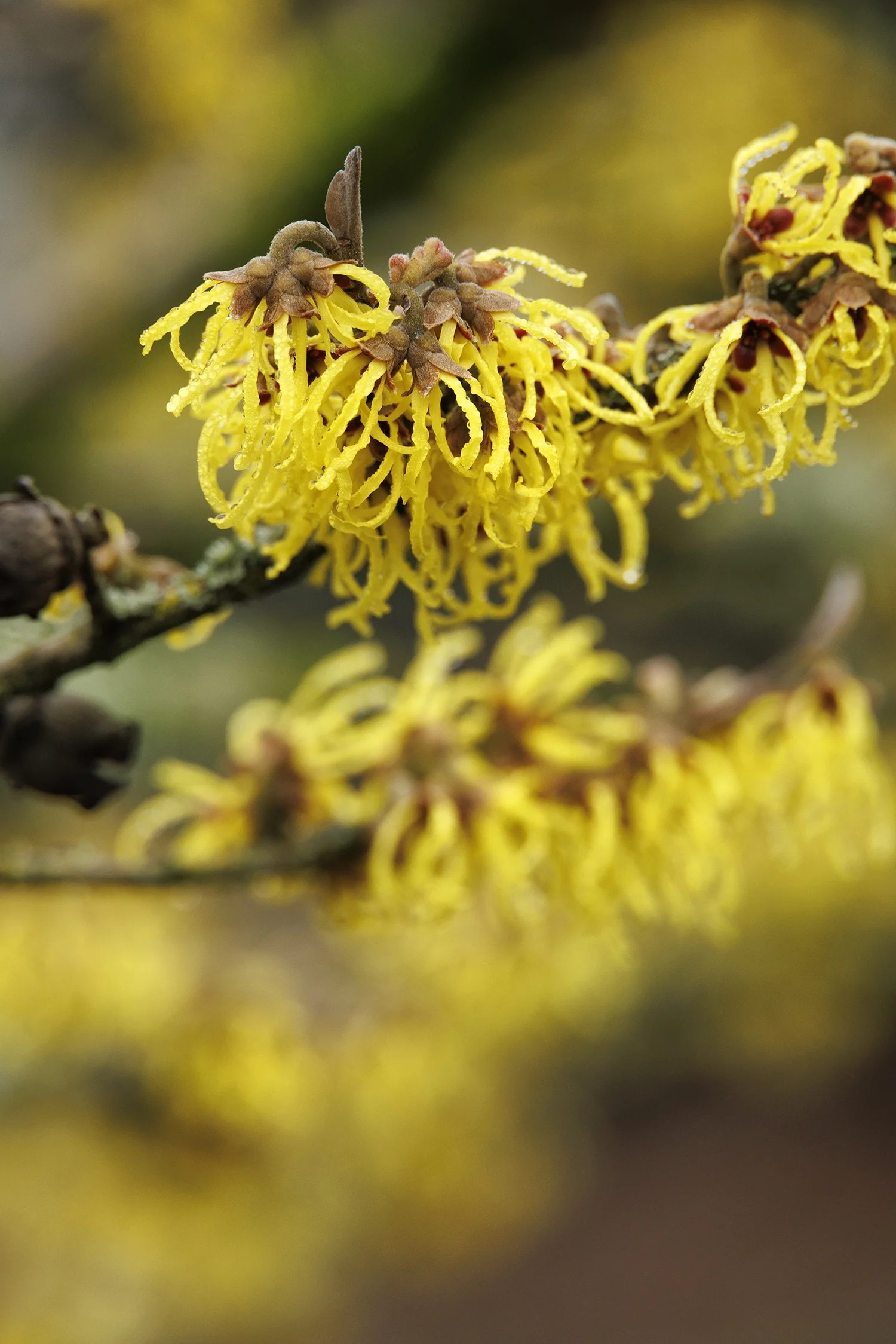Common Name: Arnold Promise Witch Hazel
Bloom Time: Late winter to early spring (February–March)
USDA Zones: 5–8 (hardy in Southeastern Wisconsin)
Mature Size: 12–15 ft. tall × 10–12 ft. wide
Habit: Vase-shaped, multi-stemmed shrub
Flower Color: Bright yellow, fragrant, ribbon-like petals
Introduction
When most of the garden is still asleep under a blanket of snow, Arnold Promise Witch Hazel wakes up the landscape with a burst of sunshine-yellow blooms. One of the earliest flowering shrubs for Southeastern Wisconsin, it brings color, fragrance, and hope to late winter when gardeners need it most. Its ribbon-like petals unfurl on bare branches, often when snow is still on the ground, and perfume the air with a sweet, spicy scent.
This cultivar is part of the hybrid group Hamamelis × intermedia and is celebrated for its showy late-winter flowers, strong cold hardiness, and reliable garden performance.
Heritage Hill Nursery carries this standout selection:
👉 Shop Arnold Promise Witch Hazel
Origins & Description
Witch hazels are native to both North America and Asia, with hybrid forms (Hamamelis × intermedia) bred to combine the best traits of their parent species. ‘Arnold Promise’ was introduced by the Arnold Arboretum in Massachusetts and has since become a classic late-winter bloomer for northern gardens.
This deciduous shrub grows in a graceful, vase-shaped form, eventually reaching 12–15 feet tall and 10–12 feet wide. The standout feature is its fragrant, spidery yellow blooms, appearing in late February or March. Flowers often overlap with snowmelt, making them a rare source of early-season color and nectar.
In autumn, foliage turns brilliant shades of golden yellow, extending its ornamental value. The bark and branch structure also provide winter interest, making Arnold Promise a true four-season shrub.
Ideal Growing Conditions (Southeast Wisconsin Focus)
-
Light: Full sun to part shade. Best flowering occurs with at least 6 hours of direct sun.
-
Soil: Prefers loamy, well-drained soils, rich in organic matter. Avoid heavy, poorly drained clay.
-
Moisture: Evenly moist soil is ideal. While established plants tolerate some drought, consistent moisture supports stronger blooms.
-
pH: Slightly acidic to neutral soils (5.5–7.0).
-
Hardiness: Zone 5 hardy; thrives in Wisconsin winters with no extra protection once established.
Planting & Establishment
When to Plant:
-
Spring (April–May): After frost danger has passed.
-
Early Fall (September): Allows roots to establish before winter dormancy.
How to Plant:
-
Dig a hole twice as wide and as deep as the root ball.
-
Place the shrub so the crown is level with the surrounding soil.
-
Backfill with soil enriched with compost.
-
Water thoroughly and mulch with 2–3 inches of organic material, keeping mulch a few inches away from stems.
Spacing: Plant 10–12 feet apart if using multiple shrubs to allow room for natural spread.
Care & Maintenance
-
Watering: Regular watering the first 2 years ensures a strong root system. After establishment, only water during prolonged dry spells.
-
Feeding: In spring, apply a balanced, slow-release fertilizer or compost to promote flowering and foliage health.
-
Pruning: Minimal. Prune lightly after flowering in spring to shape or remove deadwood. Avoid heavy pruning, as it can reduce next year’s bloom.
-
Pests & Disease: Generally pest- and disease-free. Deer usually leave witch hazels alone.
-
Winter Care: No special protection needed. Flowers withstand cold snaps; petals may curl in freezing temps but unfurl again with warmer weather.
Landscape Uses & Companions
-
Specimen Plant: Place in a prominent spot where its late-winter blooms can be enjoyed. Near entryways or patios is ideal.
-
Mixed Borders: Combine with other early bloomers like hellebores or snowdrops for layered late-winter interest.
-
Woodland Edge: Thrives at the edge of a woodland garden where it can catch sunlight.
-
Four-Season Interest: Offers winter flowers, spring freshness, summer greenery, and brilliant fall foliage.
Companions: Early-blooming bulbs (crocus, snowdrops, daffodils), shade-tolerant perennials (hosta, astilbe), and other shrubs with staggered bloom times (serviceberry, viburnum).
Seasonal Calendar (Wisconsin)
-
February–March: Fragrant yellow blooms open on bare branches.
-
April–May: Leaf-out; fertilize lightly.
-
Summer: Dense green foliage provides shade and structure.
-
September–October: Leaves turn golden yellow.
-
Winter: Strong branching adds interest against snow; buds prepare for next season.
Troubleshooting
-
Poor Bloom: Usually due to too much shade or water stress in summer. Relocate to sunnier, evenly moist soil.
-
Leggy Growth: Caused by excessive shade. Light pruning after bloom helps maintain form.
-
Slow Growth: Witch hazels are naturally slow to establish; patience pays off with decades of beauty.
Ecological & Garden Value
-
Pollinators: Provides nectar for early pollinators, including bees, when few other plants are blooming.
-
Wildlife Resistance: Rarely browsed by deer or rabbits.
-
Four-Season Beauty: Flowers, foliage, and structure keep the garden attractive year-round.
-
Native Heritage: Though a hybrid, it shares traits with North American witch hazels, which were historically used for medicinal purposes.
Ready to Plant?
If you want to bring a burst of life and fragrance to the late-winter garden, the Arnold Promise Witch Hazel is the shrub for you. With its dependable bloom time, glowing fall color, and easy-care nature, it’s an excellent choice for Wisconsin landscapes.

